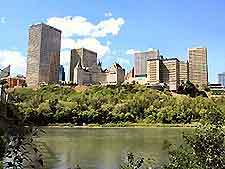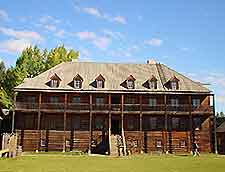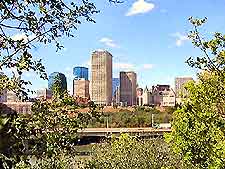Edmonton History Facts and Timeline
(Edmonton, Alberta, Canada)

The history of modern Edmonton spans a brief period, from around 1754 to the present day. However, it's now believed settlements in the area were probably established as long ago as the ending of the last Ice Age, with evidence going back to at least 3000 BC.
As the ice receded and water, timber and wildlife were re-established, early man moved north into the pristine wilderness. The city of Edmonton itself was formerly incorporated in 1904, but it saw a great deal of action prior to that date.
The Hudson's Bay Company
In the late 18th century, the famous English fur-trading company sent explorer Anthony Henday to the region to make contact with the aboriginal population in order to establish trading in the Edmonton area. By 1795, Fort Edmonton was born as a fur-trading post, set up along the bank of the Northern Saskatchewan River.
By the late 19th century, the town was a major agricultural center, with many settlers attracted by the rich, fertile soil. It also became a rallying point for miners and speculators hoping to make their fortunes from the 1897 Klondike Gold Rush. Nowadays, Fort Edmonton Park and its Living History Museum give visitors a fascinating journey back in time to the mid-19th century.

The Early 20th Century
After its incorporation in 1904 as a city with a population of 8,350, the arrival of the Canadian Northern Railway in November 1905 accelerated its development. This resulted in a real estate price boom and an amalgamation with nearby Strathcona City in 1912, as well as the building of the historic colonial Alberta Legislature. Two years later, Edmonton's population had grown to over 72,500, although the boom soon turned bust and, combined with high Canadian military enlistment numbers, caused a decline of 20,000 residents during the initial years of WWI.
Between the Wars
Following the end of WWI, the city struggled to recover its previous economic stature, as well as its population numbers, taking a back seat in Canada's development during the 1920s and '30s. The most important innovation came in 1929, with the opening of the country's first fully-licensed airfield, Blatchford Field.
As a part of the burgeoning aviation century, the airfield attracted pioneers such as Max Ward and Wilfred May. It became a main distribution point for food, medicine and mail to the far northern wildernesses of the country and earned the city the nickname of Gateway to the North. The facility is still in use today, going by the name of Edmonton City Center Airport.
WWII
From 1939 to 1945, Edmonton became the base for the construction of Canada's Northwest Staging Route and the Alaska Highway. Both routes were established to replace the threatened sea routes to
Alaska and on to
Russia, with the Northwest Staging Route being a string of small airfields constructed in the forests and tundra between the city and the Yukon border, and the Alaska Highway its ground transportation equivalent. Edmonton thus became the headquarters of the Air Transport Command's Alaskan Wing.
Nowadays, the Alaska Highway is considered the unofficial extension of the great Pan-American Highway, giving motorists the opportunity to drive the entire route from
Argentina to the Arctic, with Edmonton at its Canadian heart. The famous Milepost guidebook to the highway is still published annually, although modern-day re-routing to bypass built-up areas has shortened the road somewhat.

Post-War Development
In the immediate post-war period, the discovery of oil sands and gas fields close to the city boosted its economy and gave it another nickname - the Oil Capital of Canada. Revenue from the petrochemical industry boosted a variety of industrial, technological and educational initiatives, and by the 1970s and '80s, financial industries, including banks, were well established, although these fared badly during the economic turmoil of the late 1980s.
The present-day Edmonton metropolitan area holds over two million inhabitants, making it the largest northernmost North American city. It is now a staging point for oil sand production and diamond mining.
 The history of modern Edmonton spans a brief period, from around 1754 to the present day. However, it's now believed settlements in the area were probably established as long ago as the ending of the last Ice Age, with evidence going back to at least 3000 BC.
The history of modern Edmonton spans a brief period, from around 1754 to the present day. However, it's now believed settlements in the area were probably established as long ago as the ending of the last Ice Age, with evidence going back to at least 3000 BC.
